LET THE GAMES BEGIN!
Area schools send hundreds to chessboards, big meets 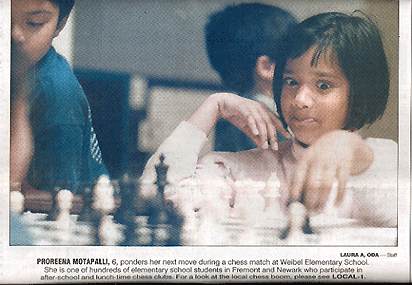
April 15, 2002
By Sandhya Somashekhar
STAFF WRITER, THE ARGUS
It's a sunny afternoon in Fremont, and the Blacow Elementary School playground is
swarming with children after a long day in the classroom.
In the relatively dim light of Room 24, though, about 12 youngsters still sit in
their chairs, watching Hans Poschmann move chess pieces across an upright board.
"Never take off your thinking caps, OK?" he tells them. "Always think
if there's a better way, and do it."
In a flash, the students couple off, a perfectly arranged chessboard between each
pair.
They don't even glance out the window.
Across the country, the popularity of chess is booming, largely because of chess
clubs at the grade school level, according to the United States Chess Federation.
More than 800 elementary school students in Fremont and Newark participate in after-school
and lunch-time chess clubs, and hundreds of others in the Tri-City area play as part
of private math lessons or weekend community clubs.
For the past few years, local programs have been churning out young chess stars who
routinely take top awards at state competitions, said Alan Kirschner, an Ohlone College
political science professor who runs scholastic chess programs throughout the area.
Last year, Weibel Elementary School in Fremont won a national championship tournament
in San Jose, and Kirschner was voted coach of the year by the Chess Education Association.
And Fremont kids dominated the California Chess State Scholastic Championships in
Monterey earlier this month, placing in nearly every category. Weibel, where the
program is 300 students strong, took the first-place trophy for overall performance
for the third straight year.
ABOVE: Sachin Zutshi, 6, plots his next move.
BELOW: Ruben Muresan, 12, contemplates his strategy.
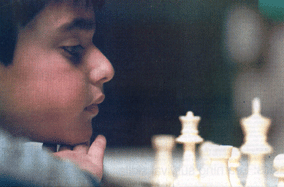 |
Kirschner attributes the success of local programs to the energetic leadership of
adult chess fans and to the academically inclined -- largely immigrant -- nature
of the community.
"Chess is seen as a nerd sport, and we happen to live in a nerd community,"
he joked. "I'm the biggest nerd of them all."
If you ask students why they play a "nerd sport," they'll tell you it's
fun.
If you ask them why it's fun, they produce a simple and ready answer.
"I like to beat people in chess," said Sachin Zutshi, a first-grader at
Weibel. |
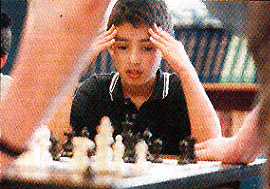 Like
physical sports, chess appeals to youngsters' competitive instincts, Kirschner said.
But research shows it also enhances their ability to concentrate, to think logically
and to solve problems, and it can improve a student's proficiency in math and reading.
Like
physical sports, chess appeals to youngsters' competitive instincts, Kirschner said.
But research shows it also enhances their ability to concentrate, to think logically
and to solve problems, and it can improve a student's proficiency in math and reading.
Parents say kids who can't sit still in class manage to concentrate for hours over
a chess board. Teachers say they see a marked improvement in some children's behavior
and academic performance.
Trent Anderson, a sixth-grade teacher at Blacow and an adviser for the school's chess
club, said the sport provides a confidence boost for kids who aren't athletically
inclined but want to participate in after-school activities.
And students who are struggling to learn English can show off their intellectual
ability.
"This is a place where they can excel when they struggle in class," Anderson
said. "This is universal."
While the Weibel program and programs at other Fremont schools have been in place
for years, Blacow just began offering chess this year. So did Milani, Snow and Bunker
elementaries in Newark.
Chess at Lincoln Elementary in Newark, under the leadership of Principal Robert Foley,
has been steadily growing in popularity over the past four years. With about 45 students
who actively participate in the lunch-time club, it rivals the school's lunch-time
softball team in popularity.
"I've always been a fan of chess. I've had a chess program at every school I've
been at," said Foley, a class C amateur player. "It's really very popular
in this area right now."
Next year, Foley said, he hopes to spread the program to Newark's four other elementary
schools.
Kirschner said that's how the popularity of chess spreads.
"Once one program begins to excel, it's a matter of competition, keeping up,"
he said. "It explodes from one school to the next."
Weibel has the undisputed largest, most successful program in the area -- and it's
not hard to see why.
On Friday afternoons, the older students sit silently in the multipurpose room, shifting
plastic knights, pawns, rooks and other pieces across flat canvas boards used for
instruction.
Behind a curtain on stage are the kindergarteners and first-graders, sometimes being
lectured by fourth- and fifth-graders who play chess like others play their Sony
PlayStations.
During a recent lesson, fifth-graders Tarry Chen and Ashwin Aravind explained to
the youngsters a move called the "en passant" -- in which a pawn, the lowliest
of chess pieces, captures another pawn on an adjacent square.
"Why can't the white pawn kill the black pawn?" a young student asks Chen
and Aravind, who demonstrate the move on an upright board.
"Because pawns can't move backwards," Chen explains. 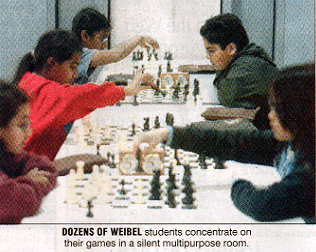
The peer teaching has been a recent success for the program, Kirschner said. The
older students not only teach the younger students moves the teachers may have trouble
with, they also hold conferences with parents, if they request them, and keep the
children's behavior in check.
Chen and Aravind stroll up and down the stage, watching the youngsters squirm in
their seats, electrified with the competitive spirit. They also encourage sportsmanship
when one player emerges victorious.
"You know the old saying, that you learn more through losing than through victories?"
Chen said. "It's kind of like that. That's why chess is so good."
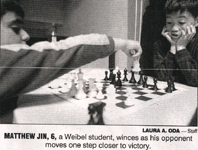
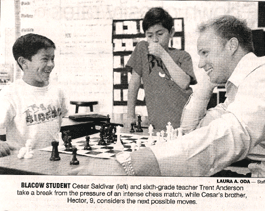


 Like
physical sports, chess appeals to youngsters' competitive instincts, Kirschner said.
But research shows it also enhances their ability to concentrate, to think logically
and to solve problems, and it can improve a student's proficiency in math and reading.
Like
physical sports, chess appeals to youngsters' competitive instincts, Kirschner said.
But research shows it also enhances their ability to concentrate, to think logically
and to solve problems, and it can improve a student's proficiency in math and reading.


